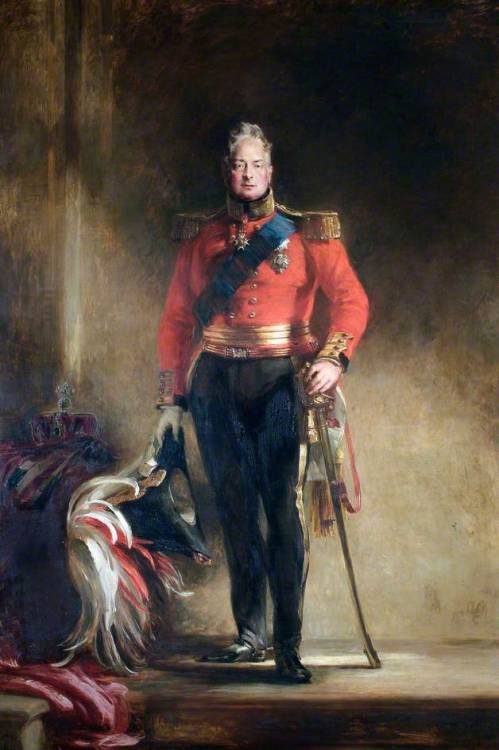#william iv
William IV (1765-1837)
Sir David Wilkie, 1833
William IV (William Henry; 21 August 1765 – 20 June 1837) was King of the United Kingdom of Great Britain and Ireland and King of Hanover from 26 June 1830 until his death in 1837. The third son of George III, William succeeded his elder brother George IV, becoming the last king and penultimate monarch of Britain’s House of Hanover.
William served in the Royal Navy in his youth, spending time in North America and the Caribbean, and was later nicknamed the “Sailor King”. In 1789, he was created Duke of Clarence and St Andrews. In 1827, he was appointed as Britain’s first Lord High Admiral since 1709. As his two older brothers died without leaving legitimate issue, he inherited the throne when he was 64 years old. His reign saw several reforms: the poor law was updated, child labour restricted, slavery abolished in nearly all of the British Empire, and the British electoral system refashioned by the Reform Act 1832. Although William did not engage in politics as much as his brother or his father, he was the last British monarch to appoint a prime minister contrary to the will of Parliament. He granted his German kingdom a short-lived liberal constitution.
At the time of his death, William had no surviving legitimate children, but he was survived by eight of the ten illegitimate children he had by the actress Dorothea Jordan, with whom he cohabited for twenty years. Late in life, he married and apparently remained faithful to Princess Adelaide of Saxe-Meiningen. William was succeeded by his niece Victoria in the United Kingdom and his brother Ernest Augustus in Hanover.
SirDavid Wilkie RA (18 November 1785 – 1 June 1841) was a Scottish[1][2] painter, especially known for his genre scenes. He painted successfully in a wide variety of genres, including historical scenes, portraits, including formal royal ones, and scenes from his travels to Europe and the Middle East. His main base was in London, but he died and was buried at sea, off Gibraltar, returning from his first trip to the Middle East. He was sometimes known as the “people’s painter”.
Post link

This 1791 print is entitled “THE LUBBER’S HOLE… alias… the Crack’d JORDAN” because Gillray believed wholeheartedly in CAPITALIZATION. The speech bubble is a nonsensical nautical cry of glee (an articulate “Yar! Yar! Yar!”) because Gillray had no freaking clue how the hell sailors talked.
The subjects of the painting are the actress Dorothea Bland, who went by Mrs. Jordan (Mr. Jordan was what one would call a figure of speech) and was famous for doing cross-dressing comedic roles at the Drury Lane Theatre, and the Duke of Clarence, the third son of George III and a member of the Royal Navy, as can be seen with the blue and gold coat hanging on the wall.
Jordan is, unfortunately, a slang word for “chamber pot”. Mrs. Jordan was well-known for her vulgarity, and the number of men who made her their mistress and later tired of her, hence her representation as a cracked chamber pot on legs. By far the most famous of her… suitors… was the Duke of Clarence, who gave her ten children and dickishly told her she’d get a pension only if she gave up the stage. Mrs. Jordan did so, but was forced to return to the stage when one of her sons-in-law fell grievously into debt. Her pension vanished and she died in poverty in France, as did a number of Regency celebrities. Fleeing to France in poverty was basically the 18th century equivalent of going into rehab.
The Duke of Clarence later became a king of England (King William IV), but most people thought he was a really crappy sailor, too distracted by impregnating Mrs. Jordan to actually do anything of consequence. The fact that he did not take part in the Napoleonic wars because he had fallen down some stairs drunk and broken his arm, thus rendering himself incapable of command and convincing the Lords of Admiralty that he was too dumb to live, did not do him any favors. Gillray calls attention to this by making the Duke of Clarence go through the lubber’s hole. It was a naval tradition to get up to the crow’s nest by climbing the diagonal netting up to 50 feet above the deck instead of just climbing up the mast and pulling oneself through a hole (the lubber’s hole) to the platform of the crow’s nest. Real men, you see, don’t follow safety precautions.
However, by the time he became William IV, everyone was royally pissed off at his elder brother George IV, who had massively overspent his income, gone completely mad, and horrified most of British society with his hedonism and his lechery, and William IV was welcomed with open arms. William IV was better received as King of England than Duke of Clarence (the Duke of Wellington said that he “he had done more business with King William in ten minutes than he had with George IV in as many days”). Despite his conservative opinions, his reign saw a large number of reform bills, the total abolition of slavery, a weakening of the generally conservative House of Lords, a welfare bill, and the establishment of child welfare laws. This came, of course, with a weakening of monarchical influence.
Since the House of Hanover was known to have porphyria and a genetic history of stupidity, this could be seen as a good thing.
Source: http://gillraysprintshop.blogspot.com/2009/01/lubbers-hole.html

